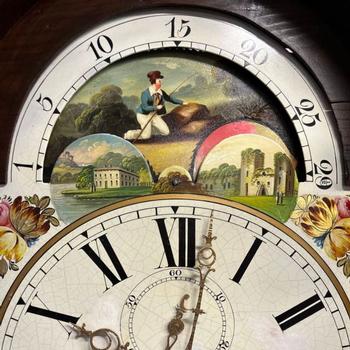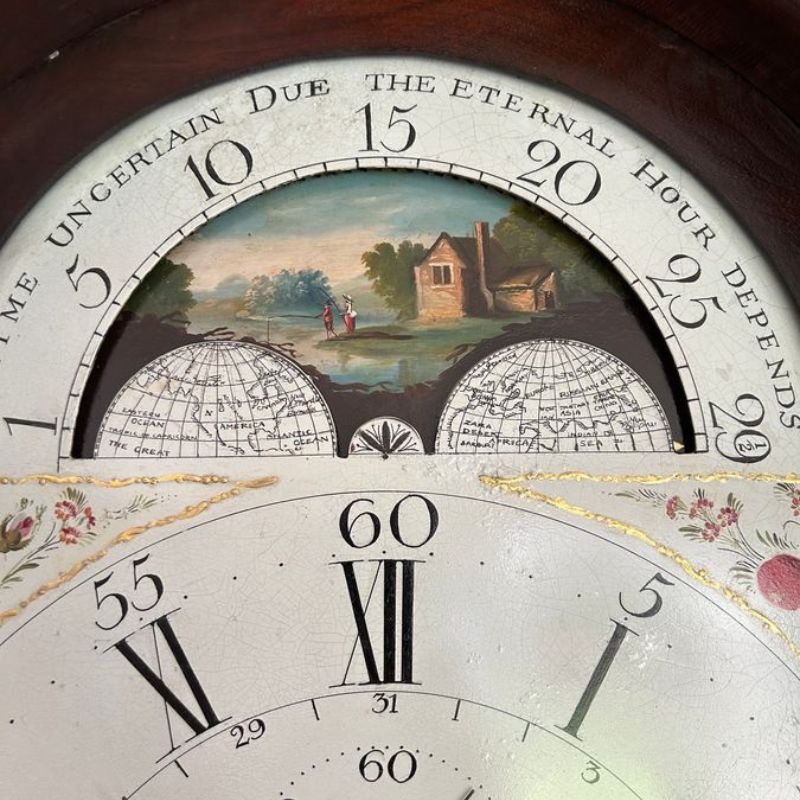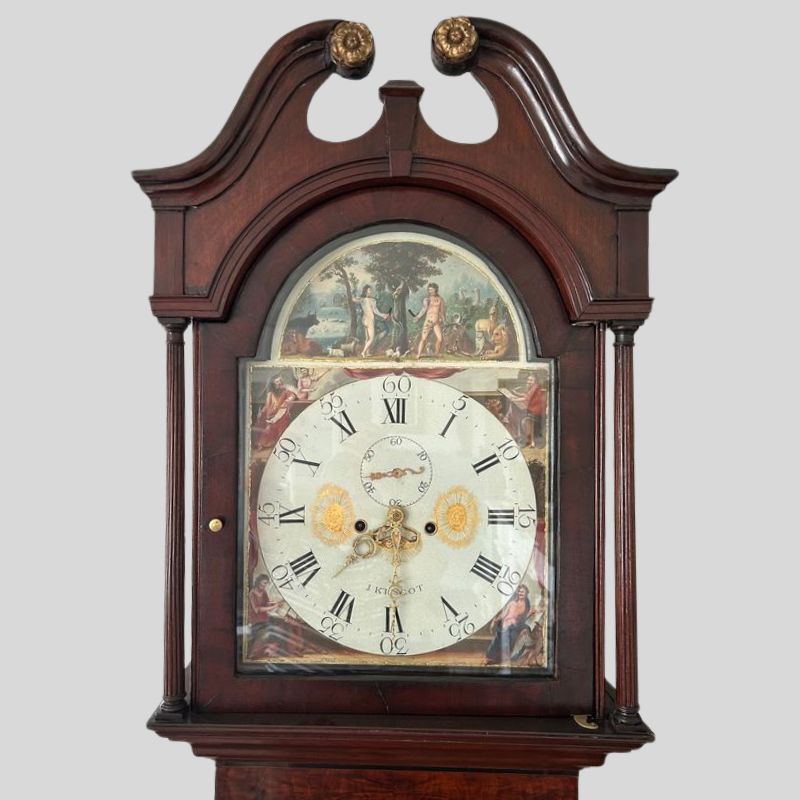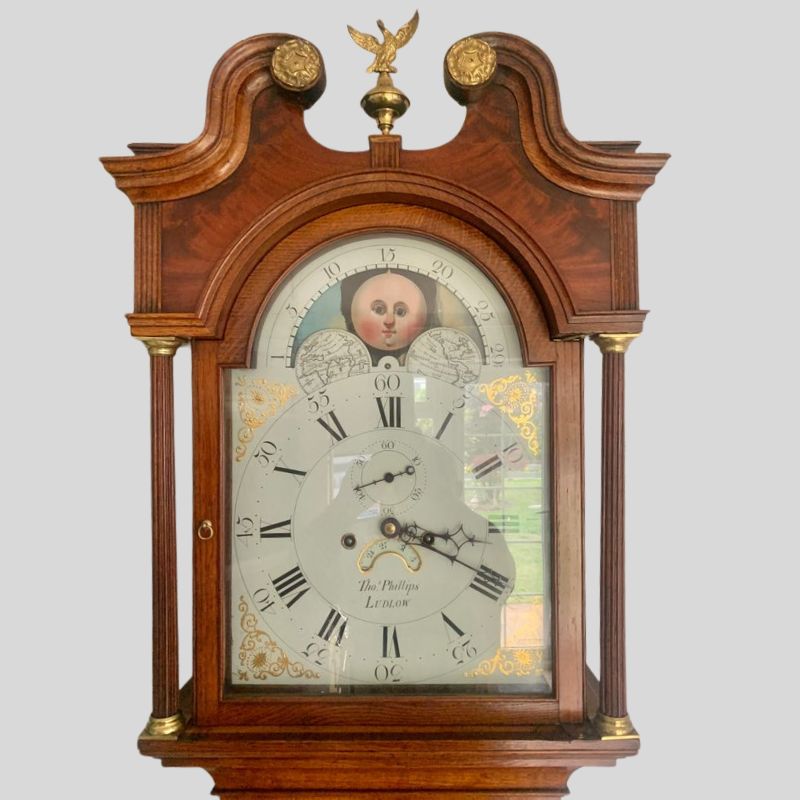featured item

quality pair of antique edwardian postal scales and weights Read more
A Brief History of Time: Antique Grandfather Clocks
Posted by Chris on 08/08/2025
You may remember them simply from visiting elder relatives’ houses, or even stately homes. After all, they are the embodiment of the term, ‘antique’, in many people’s minds. But have you ever stopped to wonder how we ended up with our beloved ‘grandfather’ clocks? And the surprising reason why we call them ‘grandfather’?
Find answers to these, as we chart the rise and fall of grandfather clocks.
The longcase clock: an iconic symbol
Also known as longcase clocks, ‘Grandfather’ clocks have a rich and fascinating history that dates back to the 17th century. These tall, freestanding timepieces are admired both for their mechanical precision and for their elegant and often intricate designs. Over the centuries, they have become iconic British symbols of tradition, craftsmanship, and domestic pride.
Above: Fully restored 1740 longcase clock by Samuel Whalley, £1,895 / $2,544
Origins of the grandfather clock
The origin of the grandfather clock can be traced to the invention of the 'anchor escapement mechanism' by English clockmaker William Clement in 1670. This innovation allowed for longer pendulums, which made clocks more accurate and consistent in keeping time. To house these longer pendulums and the weights that powered the clock, taller cases were required, leading to the development of the longcase design.
Above: Antique grandfather / longcase clocks like this fine Georgian example (circa 1785) often feature intricate detailing on the clock face, with rotating scenes from the rural and natural world, and night sky. Price: £2,245 / $3,014
Rise in popularity
Throughout the late 17th and 18th centuries, grandfather clocks became increasingly popular in Britain. They were often found in the homes of wealthy families, acting as both functional timekeepers and status symbols. Clockmakers across the country began crafting these clocks, and each region developed its own distinct style. For example, clocks from London were known for their fine detailing and craftsmanship, while those from the North of England tended to be more robust and practical in design.
![By Henry Clay Work (died 1884) - 1876 sheet music published by C.M. Cady (d. 1889)Via [1], Public Domain](/files/960px-GrandFathersClockWorkCover.jpg)
Above: the reason why we now call longcase clocks by the popularised term, 'grandfather' clocks. Image: Wikimedia public domain
Why we really call them ‘grandfather’ clocks
You may be surprised to find out that the name ‘grandfather clock’ actually came much later, in the 19th century, and was inspired by the American song My Grandfather’s Clock written by Henry Clay Work in 1876. The song tells the story of a beloved old clock that stood in the hallway and stopped ticking the moment the grandfather passed away. The popularity of the song led to the term being widely adopted, especially in the United States and later in Britain.
Above: a fabulous 1785 longcase clock featuring Adam & Eve illustrations. Price £2,400 / $3,222
Decline in popularity
During the Industrial Revolution, mass production methods made grandfather clocks more affordable, allowing middle-class families to own them. However, by the early 20th century, their popularity declined with the rise of smaller, more modern timekeeping devices such as wristwatches and mantel clocks.
Collectability of antique grandfather clocks
Today, grandfather clocks are still appreciated for their historical and decorative value. Antique models are highly sought after by collectors, while modern reproductions remain a feature in traditional homes. These clocks stand as a testament to the artistry and innovation of past generations, continuing to tick away as a reminder of time’s unrelenting passage.
All antique clocks are special but none more so than the Grandfather Clock with its commanding presence, a reminder of the splendour and skilled artisans of times gone by. And especially so in today's digital age, where the absence of physical, mechanical artefacts and sounds is so noticeable. The regular chiming and ticking of a grandfather clock helps bring a hallway or study back to life.
These stately and imposing antique clocks are a wonderful heirloom to pass down through the generations.
Above: a late Georgian (1795) antique longcase clock by Thomas Phillips of Ludlow, with rotating display above clock showing the face of the moon. Price: £1,850 / $2,486
Antique grandfather clocks on Antiques.co.uk
You'll find plenty of fabulous examples of antique grandfather clocks listed right here on Antiques.co.uk.
Many of these are listed by North West Grandfather Clocks, specialist restorers based in Cheshire, UK.
How much does an antique grandfather clock cost?
This can vary, depending on the quality of the grandfather clock, its age, and rarity. You'll typically see antique grandfather clocks range in age from the early 1700s, right through until the late 1800s.
Finer examples include this 8 day longcase clock from circa 1760 listed at £3,250; the cheapest listed by North West Grandfather Clocks is this antique longcase clock circa 1790, listed at £895.
> Explore more antique longcase / grandfather clocks on Antiques.co.uk








